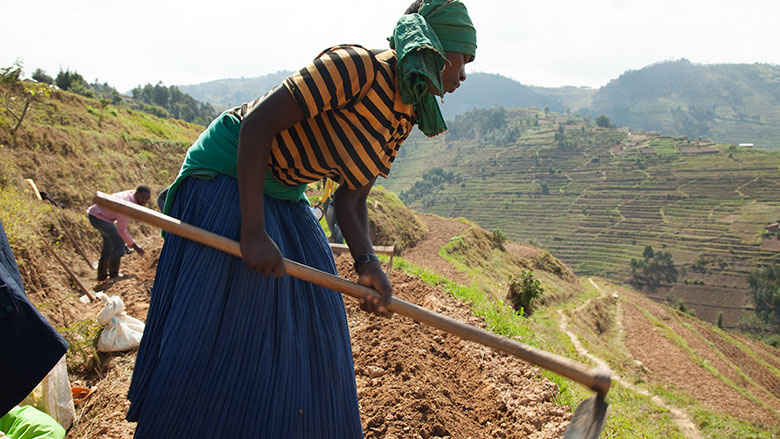Challenge
Rwanda has made remarkable progress since the civil war and genocide that started in October 1990 and ended in July 1994. GDP per capita increased from $228 in 1995 to $718 in 2014. The poverty headcount ratio using the national poverty line fell from 78% in 1995 to 45% in 2010/11.
Rwanda’s GDP per capita (constant US dollars) increased by 5% per annum in the last decade, but given the 2.7% rate of population increase, this growth rate would need to be accelerated further to achieve sustained poverty reduction and in order to meet Rwanda’s ambitions to achieve lower middle-income status by the end of the decade.
Currently, growth remains driven by the public sector financed by foreign aid (30-40% of the budget is financed by foreign aid). Diversification of the economy and growth of the private sector is constrained by: (i) low energy access rates (at around 20% in 2014) and the highest cost in the region (still at around $0.22 per kwh in 2014); and (ii) high transportation costs compared to regional averages. Costs from the main ports of Mombasa and Dar es Salaam are estimated to be at least 70% higher than that in the rest of the East African Community (EAC) region and account for about 40% of the cost of imported goods and 50% of exported goods. Despite an adverse external environment, Rwanda has maintained steady growth at 6.9% in the first three quarters of 2015, almost the same as the average over the past five years and the country’s potential growth. Annual average inflation rate at 2.5% in 2015 was less than half of that of other EAC countries.
Approach
With IDA funding, the Bank’s analytic work that helped inform the development of Rwanda’s medium term 2008-2013 Economic Development and Poverty Reduction Strategy (EDPRS), concluded clearly that increasing agricultural productivity and commercializing production would be critical to achieving Rwanda’s vision for structural transformation from subsistence agriculture to a middle income economy.
The Bank embarked accordingly on a program of investment lending support first using a three phased Adaptable Program Loan consisting of the Rural Sector Support Project (RSSP) that since 2001 has focused on intensifying production in the marshlands, and by the Land Husbandry, Water Harvesting and Hillside Irrigation (LWH) Project that started in 2010 and focuses on developing horticulture and food crop production on the hillsides. These long-term programs have enabled the government to make significant progress on its agricultural intensification objectives through investments in infrastructure for irrigation and erosion control, for the provision of quality inputs, and for capacity building of all the stakeholders in various agricultural value chains. These programs have also incorporated a number of innovations such as the farmer based extension model that has led to increased rice productivity and a comprehensive land husbandry package that has enabled effective erosion control and soil fertility restoration at the landscape level.
Starting in 2008, an annual development policy operation (the Poverty Reduction Support Financing) has underpinned critical policy reforms in the agriculture sector including: (i) improving planning and predictability of funding for the agricultural sector to allow for more effective spending on input distribution, irrigation, water, and soil management; (ii) promoting the emergence of a private sector procurement and distribution system for agricultural inputs, especially fertilizer; and (iii) capacity building of private sector agro-dealers.
